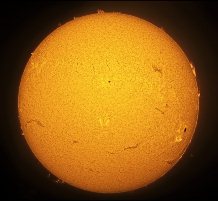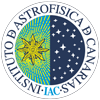
Solar Physics
The Sun constitutes a physics laboratory with complex interactions between its electrically conducting plasma and a strong magnetic field, in conditions that cannot be reproduced in our laboratories.
A new paradigm has been emerging that involves a connected view of the solar atmosphere linked by the magnetic field from the solar interior to the outer corona, as well as detailed local helioseismology in sunspots, loops and other magnetic features. The solar physics group of the IAC holds a leadership position in the investigation of the Sun in the framework of this global paradigm as exemplified by its role in major projects like the European Solar Telescope, the Solar Orbiter mission of ESA or the NASA-JAXA-IAC Chromospheric Ly-alpha Spectropolarimeter and the leadership of the European Network SOLARNET.
The group's expertise is at the forefront of the international research, striving in the coming years to understand how the magnetic fields emerge from the solar interior through the surface and rise to the upper atmosphere leaving in the meantime its imprint of complex interaction and releasing part of its energy to the medium. The IAC's expertise in the development of polarimetric instrumentation [TIP & LPSP ; Sunrise ; EST ; Solar Orbiter], in the development and application of diagnostic techniques for magnetized plasmas and in 3D numerical radiation-MHD modelling has established the team as one of the most competitive and scientifically prepared in the world.
Goals:

- To perform realistic 3D modelling of the dynamics and radiative processes in the solar atmosphere using massively parallel computers;
- develop new diagnostic methods based on radiative transfer of polarized light;
- carry out ground-breaking observations from new ground and space facilities with unprecedented spatial resolution, time cadence and polarimetric sensitivity;
- establish a model of Earth’s globally-averaged radiation balance.
Specific Scientific Outputs:
2012
- A 3D modelling of the Sun has already been developed. As a first result it led to a revision of the iron content in the solar atmosphere with deep implications in our understanding of the solar interior (Astronomy & Astrophysics vol. 548, pp 12).
- The conceptual design phase of the EST has been successfully concluded. IAC leads the EST detailed design phase (29 partners involved in 14 countries) with the support of the EU FPVII.
- IAC leads the Spanish participation in Solar Orbiter with a co-PI. This project has now entered the construction phase.
- IAC leads the FPVII network SOLARNET.
2013
- A study on how objective analyses of short-timescale solar–terrestrial investigations may be reliably performed was published in the Journal of Space Weather Space Climate. Laken & Čalogović (2013) also reported on further investigations into the ways in which sampling issues can influence investigations into the solar–terrestrial linkages.
- The SOPHI Science Operations Working Group, with the participation of the IAC Co-PI, made progress in defining the operations of the instrument on Solar Orbiter during its lifetime. The scientific team also progressed in the preparation of the scientific calibration software of the SOPHI Full Disk Telescope. The engineering team participated, as part of the board, in the detailed design review of the Image Stabilization System of SOPHI and in the panel of reviewers for the software Preliminary Design Review. The IAC engineering team also started to prepare with INTA the requirements for the coelostat, in the optical ground support equipment needed for the verification of the instrument.
- SOLARNET Transnational Access and Service Program and Mobility of Young Researchers Program started. More than 80 people from 15 countries benefited.


